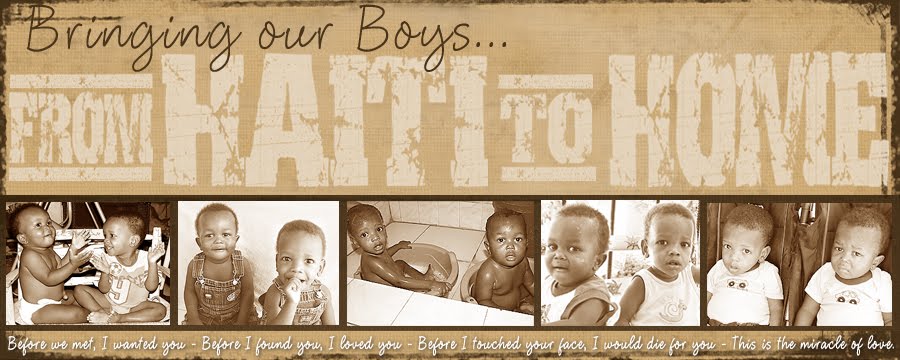By JONATHAN M. KATZ, Associated Press Writer Thu Sep 4, 9:19 AM ET
GONAIVES, Haiti - Entering a flooded city on inflatable boats, U.N. peacekeepers found hundreds of hungry people stranded for two days on rooftops and upper floors Wednesday as the fetid carcasses of drowned farm animals bobbed in soupy floodwaters.
Haiti seems cursed this hurricane season, with its crops ruined and at least 126 people killed by three storms in less than three weeks. Even as Tropical Storm Hanna edged away to the north, forecasters warned that a fourth storm — Hurricane Ike — could hit the Western hemisphere's poorest country as a major storm next week."If we keep going like this, the whole country is going to crash," moaned Mario Marcelus, who was trying to reach his family in Gonaives but didn't dare cross the floodwaters.
Rescue convoys had been trying to drive into Gonaives, Haiti's fourth-largest city, but kept turning back because lakes formed over every road into town. On Wednesday, Associated Press journalists accompanied the first group of U.N. troops to reach the city aboard Zodiac boats.
Argentine soldiers based in Gonaives plucked residents from rooftops that were the only visible parts of their houses. In a cemetery, only the tops of tombs glimmered beneath the water. The carcasses of dead animals, including a donkey and a cow, floated amid debris as flies swarmed.
About 150 people were crowded into a church. Most retreated to a large balcony above the floodwater, where they waited in misery for the waters to recede.
"There is no food, no water, no clothes," said the 37-year-old pastor, Arnaud Dumas. "I want to know what I'm supposed to do. ... We haven't found anything to eat in two, three days. Nothing at all."
The Gonaives area, where about 110,000 people live, accounted for most of the 2,000 victims of Tropical Storm Jeanne in 2004. Some residents said the current flooding was at least as bad, and criticized the government for failing to implement safety measures in the past four years.
"This is worse than Jeanne," said Carol Jerome, who fled from Gonaive on Tuesday.
About two-thirds of Gonaives was covered in mud, although it was difficult to determine the extent of the flooding from the air, U.S. Coast Guard spokesman Matt Moorlag said after planes conducted flyovers. Severe weather prevented the planes from assessing the situation in the surrounding mountains, and there was no way to reach the area.
In the chaos, there was no way of knowing how many people might be dead in the area, or how many had been driven from their homes. People kept a wary eye on water levels, which appeared to be holding steady on Wednesday as Hanna moved farther offshore.
On the ground, men used pieces of styrofoam as kickboards to try to swim out of town. People waited for help along the shores of the newly formed lake, and Interior Minister Paul Antoine Bien-Aime said people stranded on rooftops were becoming increasingly desperate.
"It is a great movement of panic in the city," Bien-Aime told AP as Brazilian soldiers assigned to the 9,000-member U.N. force carried him onto an idling speedboat.
Businesses were closed — both because of flooding and for fear of looting — and supplies were running short. People in water up to their knees called to Argentine peacekeepers in Spanish, shouting "Give me water!" Women on balconies held up empty pots and waved spoons, signaling their hunger.
About 1,500 people huddled in a shelter they nicknamed the "Haiti Hilton." Director Jean-Noel Preval said there was no food and the shelter was running out of drinking water.
His cousin Jezula Preval gave birth at the shelter to a healthy boy on Tuesday night. Jezula Preval, 23, said she tried to hold out at home, but the rain drove her out and floodwaters eventually swallowed her house.
"I lost everything, even the baby's clothes," she said.
The situation was dire elsewhere in Haiti as well. Floodwaters swamped a hospital near southwestern Les Cayes, and nurses moved patients to higher floors. At least 5,000 people in Les Cayes were in shelters, said Jean-Renand Valiere, a coordinator for the civil protection department.
The U.S. Embassy in Port-au-Prince declared a disaster situation, freeing US$100,000 in emergency aid, spokeswoman Mari Tolliver said. She said hygiene kits, plastic sheeting and water jugs for up to 5,000 families are expected to arrive from Miami on Thursday.
"The biggest problem right now is just getting access to affected areas," she said.
Even as Hanna moved offshore, the National Hurricane Center in Miami said Hurricane Ike in the central North Atlantic would gain strength as it approached the Caribbean and "could reach major hurricane status" within five days.
Its course remained uncertain, but the most likely track passed just north of the Haitian coastline.
___
AP writer Danica Coto contributed to this report from San Juan, Puerto Rico.
(This version CORRECTS that floodwaters are holding steady.)












3 comments:
Praying for this country. I am deeply concerned.
We have friends who live in Bois-neff. Edna and her husband both have siblings in Gonaives. When they called yesterday they said that they were huddled on rooftops and to please pray as because no one could get in to save them and they can not get out :(
Angela
Les Cayes is where Hannah and her sister Haddassah were from!
We are in prayer for them!
lynette
Post a Comment